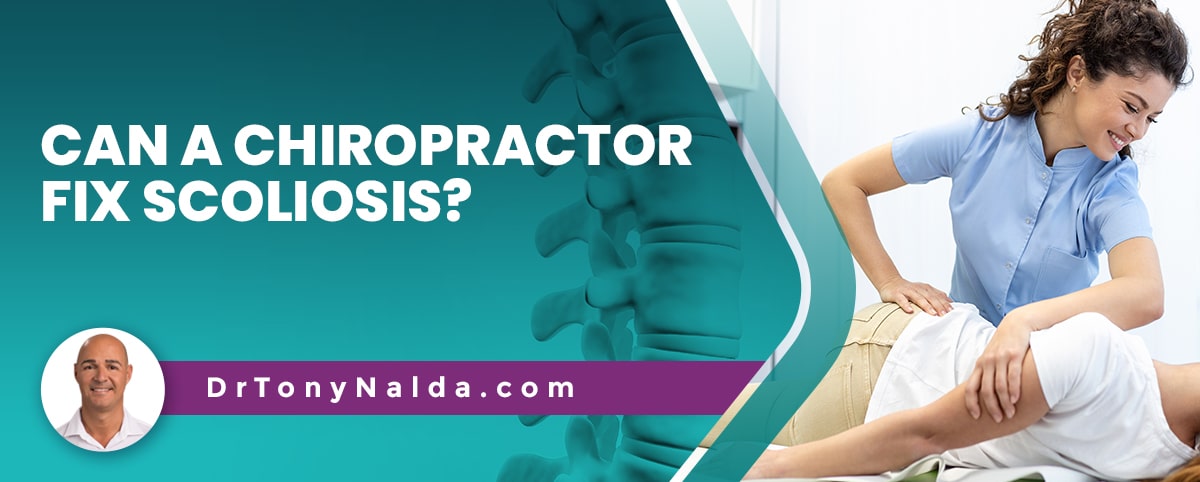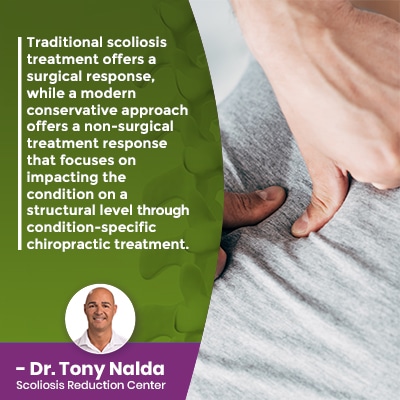Can A Chiropractor Fix Scoliosis? [ANSWERED]

Scoliosis is the leading spinal condition amongst school-aged children, and it's estimated that close to seven million people are currently living with the condition in the United States alone. The complex nature of scoliosis necessitates the customization of effective treatment plans, through the integration of multiple condition-specific treatment disciplines.
While a scoliosis-specific chiropractor can integrate chiropractic treatment into a customized treatment plan with other scoliosis-specific treatment disciplines, the complex nature of scoliosis is beyond the scope of general chiropractic and requires a multifaceted treatment approach.
As scoliosis can be such a complex condition to treat, let's start with why.
Table of Contents
Understanding Scoliosis
When it comes to how best to treat scoliosis, the key is fully understanding the condition and the underlying causes of the different condition types.
Scoliosis involves the development of an abnormal curvature of the spine that bends to the side and also twists, and it's the rotational component that makes scoliosis a complex 3-dimensional condition.
In addition, in order to be diagnosed as scoliosis, the unnatural spinal curvature has to be of a minimum size, and this is a Cobb angle measurement of at least 10 degrees.
The higher a patient's Cobb angle, the further out of alignment a scoliotic spine is, and the more severe the condition:
- Mild scoliosis: Cobb angle measurement of between 10 and 25 degrees
- Moderate scoliosis: Cobb angle measurement of between 25 and 40 degrees
- Severe scoliosis: Cobb angle measurement of 40+ degrees
- Very-severe scoliosis: Cobb angle measurement of 80+ degrees
A key condition characteristic to understand is the progressive nature of scoliosis.
Scoliosis is a Progressive Condition
 Scoliosis is a progressive condition, meaning it has it in its nature to worsen over time, and this means the size of the unnatural sideways curve of the spine is increasing, making it increasingly rigid and less responsive to treatment.
Scoliosis is a progressive condition, meaning it has it in its nature to worsen over time, and this means the size of the unnatural sideways curve of the spine is increasing, making it increasingly rigid and less responsive to treatment.
So where a scoliosis is at the time of diagnosis is not indicative of where it will stay; only proactive treatment can work towards counteracting the condition's progressive nature.
Mild scoliosis can easily progress and become moderate, severe, or very severe cases, especially if left untreated, or not treated proactively, so watching and waiting for signs of continued progression is wasting valuable treatment time because as a progressive condition, scoliosis is virtually guaranteed to get worse at some point in time.
As scoliosis progresses, not only does the spine get less responsive to treatment, but the condition develops more noticeable symptoms, and the main trigger for progression is growth, which is why children are more at risk for rapid-phase progression.
In children, postural deviation is the main symptom of scoliosis, and this includes uneven shoulders, uneven hips, and the development of a rib arch; in adults, the main symptom is scoliosis pain.
Scoliosis pain becomes an issue once skeletal maturity has been reached; this is when scoliosis becomes a compressive condition.
Compression doesn't just affect the spine, but also its surrounding muscles and nerves, and noticeable symptoms can be related to a muscle imbalance; an unnatural spinal curvature can pull its surrounding muscles in different directions, causing the muscles on one side to become loose and stretched from overuse and the muscles on the opposite side to become weak from underuse.
Adult scoliosis patients experience the following common symptoms: scoliosis pain in the back, pain muscle spasms, imbalanced back muscles, and muscle tension, and pain that radiates into the extremities due to nerve compression, but no two patients will experience scoliosis the same way.
Not only does scoliosis range so widely in severity, there are also multiple types of scoliosis people can develop.
Different Types of Scoliosis
The most common type of scoliosis to affect both children and adults is idiopathic scoliosis, and idiopathic means not clearly associated with a single-known cause.
The most prevalent type of scoliosis overall is adolescent idiopathic scoliosis, diagnosed between the ages of 10 and 18, and this age group is particularly at risk for rapid-phase progression because of the rapid and unpredictable growth spurts associated with puberty.
Approximately 80 percent of known diagnosed cases are classified as idiopathic scoliosis, while the remaining 20 percent are associated with known causes: neuromuscular scoliosis, degenerative scoliosis, and congenital scoliosis.
Neuromuscular scoliosis is caused by the presence of a larger neuromuscular condition such as muscular dystrophy, spina bifida, and cerebral palsy.
Degenerative scoliosis is caused by natural age-related spinal degeneration that most often effects the intervertebral discs, and congenital scoliosis is a rare form affecting approximately 1 in 10,000 and is caused by a malformed spine that develops in utero.
The different types are determined by causation, and its a condition's underlying cause that shapes the crafting of potentially-effective treatment plans, so as you can see, just as no two cases of scoliosis are going to present the same way, no two patient's experience will be the same, nor can two patients be treated with the same treatment plan; this is why the experience/knowledge/training of a scoliosis specialist is required to impact the condition on every level.
Chiropractic Care Can Help
There are two main scoliosis treatment approaches: traditional and conservative.
 Traditional scoliosis treatment offers a surgical response, while a modern conservative approach offers a non-surgical treatment response that focuses on impacting the condition on a structural level through condition-specific chiropractic treatment.
Traditional scoliosis treatment offers a surgical response, while a modern conservative approach offers a non-surgical treatment response that focuses on impacting the condition on a structural level through condition-specific chiropractic treatment.
I say condition-specific chiropractic treatment because the complex nature of scoliosis is beyond the scope of general chiropractic care, which could help with keeping the spine strong, flexible, and more responsive to treatment, but when it comes to working towards corrective results, a chiropractor trained in multiple scoliosis-specific treatment modalities is necessary.
As a scoliosis chiropractor, I believe in treating scoliosis proactively by starting treatment as close to the time of diagnosis as possible; this is when it's going to be its mildest form, its most responsive, and when detected early, mild cases are the simplest to treat.
A conservative scoliosis treatment plan doesn't just rely on improving spinal alignment through chiropractic adjustments that work towards adjusting the position of the curve's most-tilted vertebrae back into alignment with the rest of the spine, it also integrates physical therapy, corrective bracing, and rehabilitation.
No one treatment discipline alone is powerful enough to impact scoliosis in the different ways needed to achieve corrective treatment results; corrective results means the size of the unnatural spine curvature has been reduced on a structural level, and physical therapy and the application of scoliosis-specific exercises (SSEs) has helped strengthen the spine's surrounding muscles so they can provide optimal spinal support/stabilization.
Corrective bracing can help augment corrective treatment results by pushing the spine into a corrective position, and rehabilitation involves custom-prescribed home exercises for further healing/stabilizing the spine.
Scoliosis cases are improved through spinal manipulation that's safe, effective, and non invasive, physical therapy that addresses bad posture, any related muscle imbalance, and increases core strength for improved spinal support; lifestyle guidance on how to lead a spine- and scoliosis-friendly lifestyle can also help patients move forward with their conditions in a positive way.
Conclusion
So can a chiropractor fix scoliosis?
No chiropractic treatment on its own is enough to impact scoliosis on the different levels needed to achieve corrective treatment results; however, when chiropractic treatment is scoliosis-specific, designed by a scoliosis-chiropractor, and additional treatment disciplines are integrated into customized treatment plans, scoliosis can be highly treatable.
Conservative chiropractic-centered scoliosis treatment is non-invasive and involves spinal adjustments, physical therapy, scoliosis-specific exercises, corrective bracing, and rehabilitation.
No treatment results are ever guaranteed, but when scoliosis is diagnosed early in the condition's progressive line and is responded to with proactive conservative treatment, there are fewer limits to what can be achieved.
Here at the Scoliosis Reduction Center, I believe in a proactive response to a diagnosis by starting treatment immediately; one of my main goals of treatment is to help patients avoid the need for invasive scoliosis surgery in the future.
Spinal surgery comes with some serious potential risks, side effects, and complications, so spinal fusion should be considered carefully, and the reality is that many cases of scoliosis don't require surgery to be effectively treated.
When it comes to scoliosis pain relief, the best long-term solution is proactive treatment that offers sustainable results through continued chiropractic care and rehabilitation.
Treating scoliosis with a non-invasive and conservative approach delivered by a scoliosis-chiropractor can help each individual patient have an improved quality of life because the scoliosis is addressed while preserving as much natural spinal strength and function as possible.
Dr. Tony Nalda
DOCTOR OF CHIROPRACTIC
After receiving an undergraduate degree in psychology and his Doctorate of Chiropractic from Life University, Dr. Nalda settled in Celebration, Florida and proceeded to build one of Central Florida’s most successful chiropractic clinics.
His experience with patients suffering from scoliosis, and the confusion and frustration they faced, led him to seek a specialty in scoliosis care. In 2006 he completed his Intensive Care Certification from CLEAR Institute, a leading scoliosis educational and certification center.
About Dr. Tony Nalda
 Ready to explore scoliosis treatment? Contact Us Now
Ready to explore scoliosis treatment? Contact Us Now





